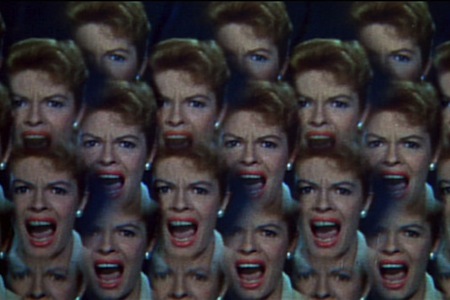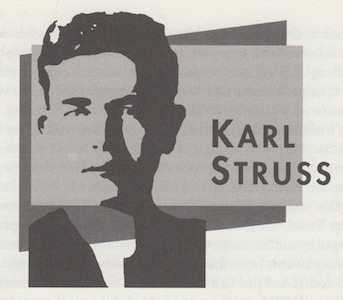Born: November 30, 1886, New York, NY
Died: December 15, 1981, Los Angeles, CA
There are few better photographers; his work is more than excellent. He is highly artistic and I cannot too highly recommend him.
—Cecil B. DeMille
Columbia graduate Karl Struss began a career in commercial photography in New York in 1916. Working extensively with autochrome film developed by the Lumière brothers, he was regarded as an early master of color photographs and soon began publishing articles in photographic journals and experimenting with new technologies. Motion photography became an increasing fascination that turned into a business opportunity in 1919, when he left the East Coast for Hollywood. In just a few years, Struss would become a celebrated cinematographer and provide film photography with its most influential lighting effects.
Immediately upon seeing a portfolio of Struss’s work, producer Jesse Lasky hired him to shoot publicity stills. Drawn to the Rembrandt-like lighting in Struss’s photos, Lasky sent his most beautiful starlets to Struss and asked him to work his magic on their promotional stills. Struss turned his camera on Gloria Swanson first, and eventually most of the silent era’s greatest names were framed by him. His beautifully artful platinum prints drove up the demand for fan photos, and his characteristic lighting style was reproduced in the famous shots of photographer George Hurrel fifteen years later.
Lasky couldn’t shake the idea that Struss might be better used behind a hand-cranked camera. He urged his favorite director, Cecil B. DeMille, to consider the quality of Struss’s stills and determine whether the photographer would be useful on a movie set. DeMille took one look at the photos of Swanson and put Struss to work immediately on For Better, for Worse (1919). Over a three-year stint as a cameraman, Struss was often called on by DeMille to finish one or two scenes as a second-unit director, which he did on Male and Female (1919), Forbidden Fruit (1920) and Poisoned Paradise (1923).
When Struss went freelance in 1924, he quickly found work as a director with Thomas Ince, then worked on various films until DeMille tracked him down and invited him back for a European trip to assist on the location shots of Ben-Hur (1926). Upon his return to Hollywood, Struss would receive offers from almost every major studio.
For his next project, he accepted a position as second cameraman to Charles Rosher on Sunrise (1927), an ambitious drama by the established horror director F.W. Murnau. Struss was given great latitude on the set of Sunrise and used many of his own techniques to create lush, fluid imagery that seems to transform each scene smoothly into the next. Struss handled lighting on the scenes of the Big City sequences and was given responsibility for the crane-and-dolly shots of several water sequences. Making use of experimental film stock, some of the earliest panchromatic negatives available, Struss was able to capture dreamlike images of light reflected off water that contributed to the film’s most memorable moments. Borrowing heavily from expressionistic lighting, Struss shot exteriors with much more light than German cinematographers had used when formulating their shots. After Struss noticed that much of his personal style had reached the screen, he demanded to be listed as a cinematographer in the film’s credits and share equal prominence with Rosher. Murnau, who is often credited for the immense influence of Sunrise, claimed to have rarely looked through the camera lens, relying heavily on the expertise of his cameramen. He relented, and Struss got the credit he deserved.
The majesty of Sunrise is achieved through the suggestive power of Struss’s photographic techniques. Its hallmark was the use of lighting to support the theme of the film. It has been called the most beautifully photographed silent film ever and was praised endlessly by the critics as the preeminent example of filmmaking for its time. The film was a tremendous influence on Orson Welles, and the French New Wave artists perched it high upon their critical pedestal. Film noir directors returned to it frequently for insights into creating mood.
Struss was quickly adopted by the industry. Asked by Louis B. Mayer to represent his trade union in the foundation of the Academy of Motion Picture Arts and Sciences, Struss was one of only fifteen cameramen invited to the first meeting to christen the organization. When the group tallied their ballots for the first annual Academy Award presentation, he would become the first Oscar winner for cinematography. There was no Best Picture category that year; but Sunrise received a special Oscar for “Unique and Artistic Picture.” Later that year, the American Society of Cinematographers (ASC) inducted Struss into its prestigious club. He would become one of its cornerstone members, even serving as the subject of a documentary short called The Cinematographer in a 1949 series the ASC sponsored about their craft.
After Sunrise, Struss would market himself as an “artist photographer.” He held out for projects that let him explore motion pictures as a means to express thought pictorially instead of by titles or dialogue. While waiting for choice projects, he maintained his expertise in modern photographic processes and continued to develop custom lenses.
In 1927, Struss moved to United Artists, where D.W. Griffith expressed an interest in having the young cinematographer aid him on four pictures, including The Battle of the Sexes and Drums of Love. Struss jumped at the chance to work alongside and share screen credit with the legendary Billy Bitzer. The experience proved to have other benefits: UA’s other stars, Mary Pickford and Charlie Chaplin, would use Struss for Coquette (1928), The Great Dictator (1939) and Limelight (1952). He was unavailable to oblige a young Orson Welles in Citizen Kane (1941) but was loaned to RKO to help Welles with Journey into Fear (1942). These films highlighted the rich visual imagery that came to be a trademark of Struss’s work.
His lighting techniques were so widely imitated, however, that he felt compelled to break away from the confinements of cinematography and took up an interest in special effects. During an eighteen-year stint at Paramount, Struss continued his experiments with trick lenses and unusual filters, leading to the eerie transformations in Dr. Jekyll and Mr. Hyde (1932) and Island of Lost Souls (1933).
When other cinematographers came up to Struss’s level in the 1950s, he began a second wave of influence. Captivated by the attempts of studios to experiment with 3-D films, he signed on for such B-movie projects as Rocketship X-M (1953) and tried his hand at wide-screen effects for the CinemaScope craze. His multi-eye view in The Fly (1958) became one of science fiction’s most indelible images, although many felt Struss was “slumming” by lending his experience to these low-budget shockers. However, Struss refused to be pigeonholed as a one-dimensional talent and continued to apply his inventive photographic ideas to a steady stream of film and television work up until 1970, when he retired.
Struss summarized his role in film history best when he wrote to a London exhibitor in 1921: “I believe I am the first of the American pictorialists to have entered the field of motion picture photography with the view of improving the presentation of films photographically.”
To read all the republished articles from ‘The Film 100,’ go to Reintroducing the Film 100 here on Keyframe.





